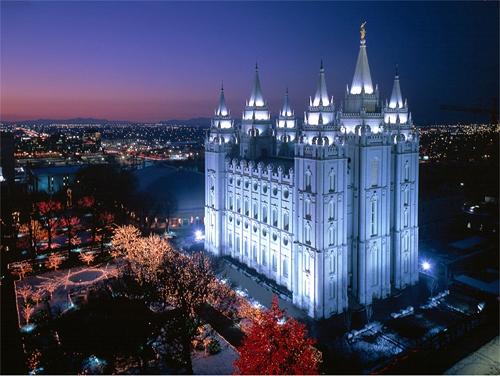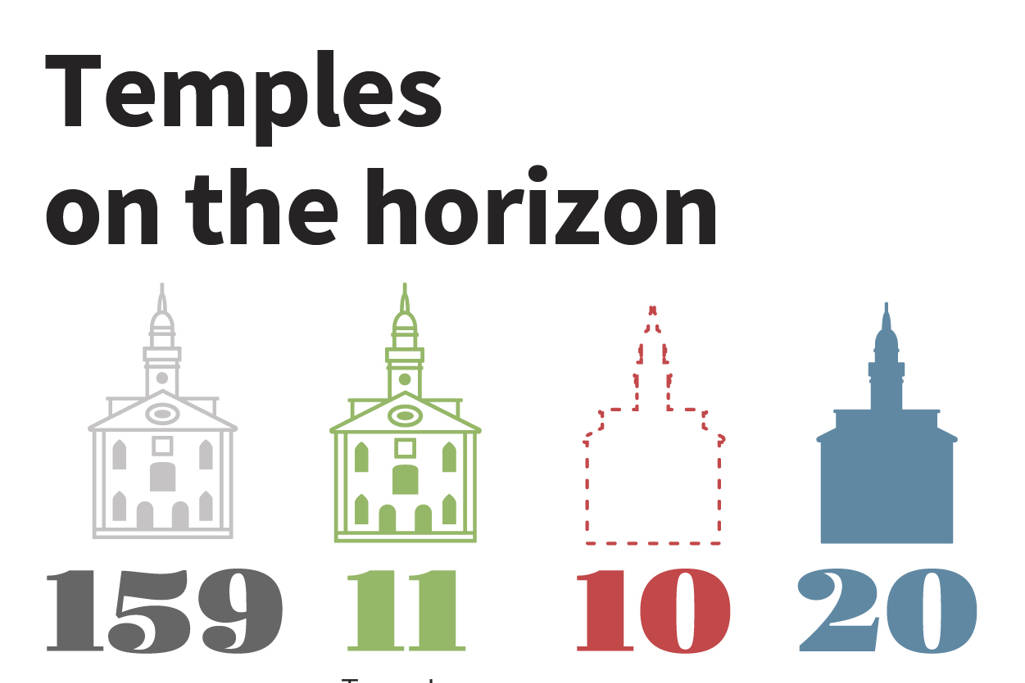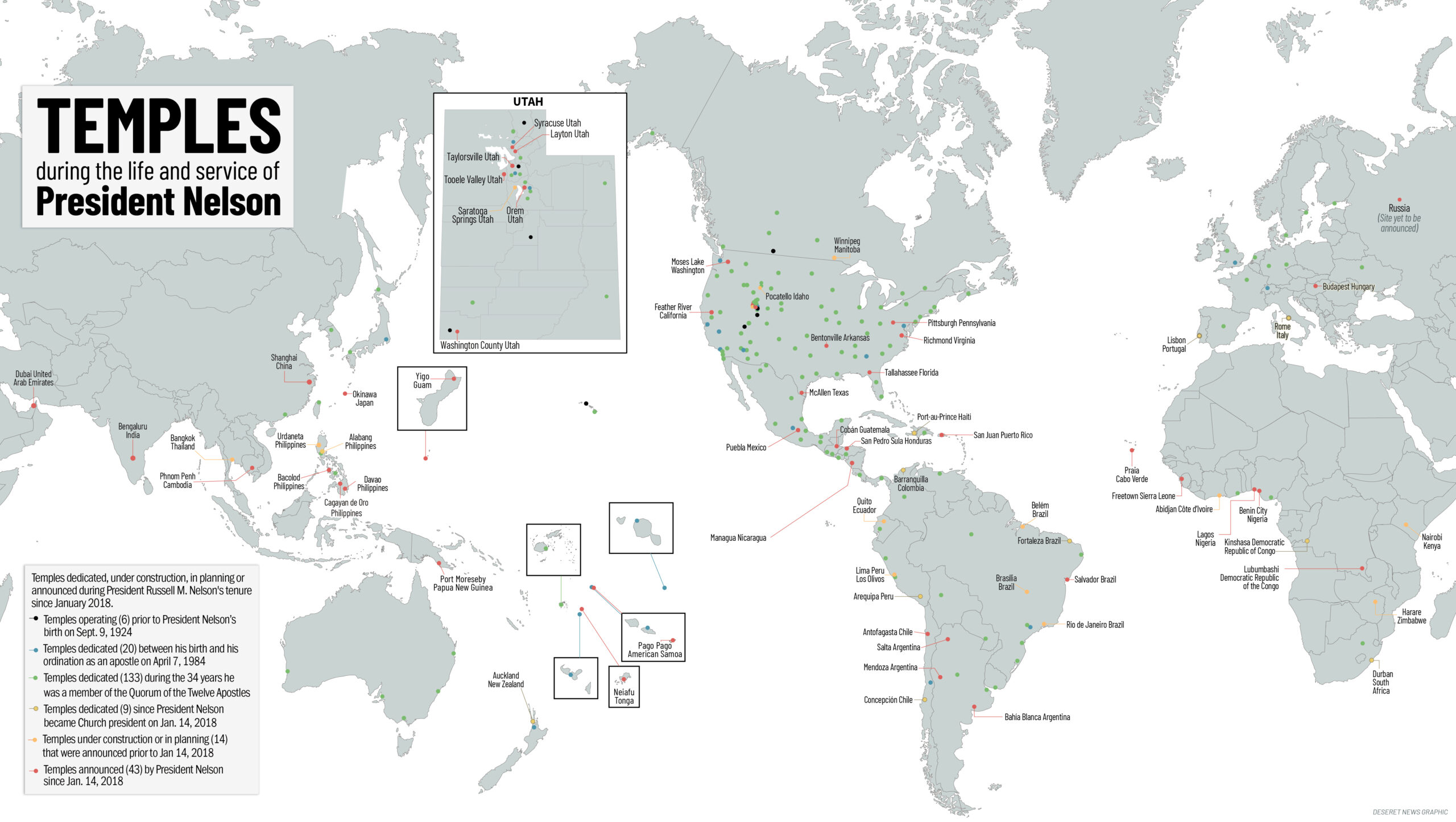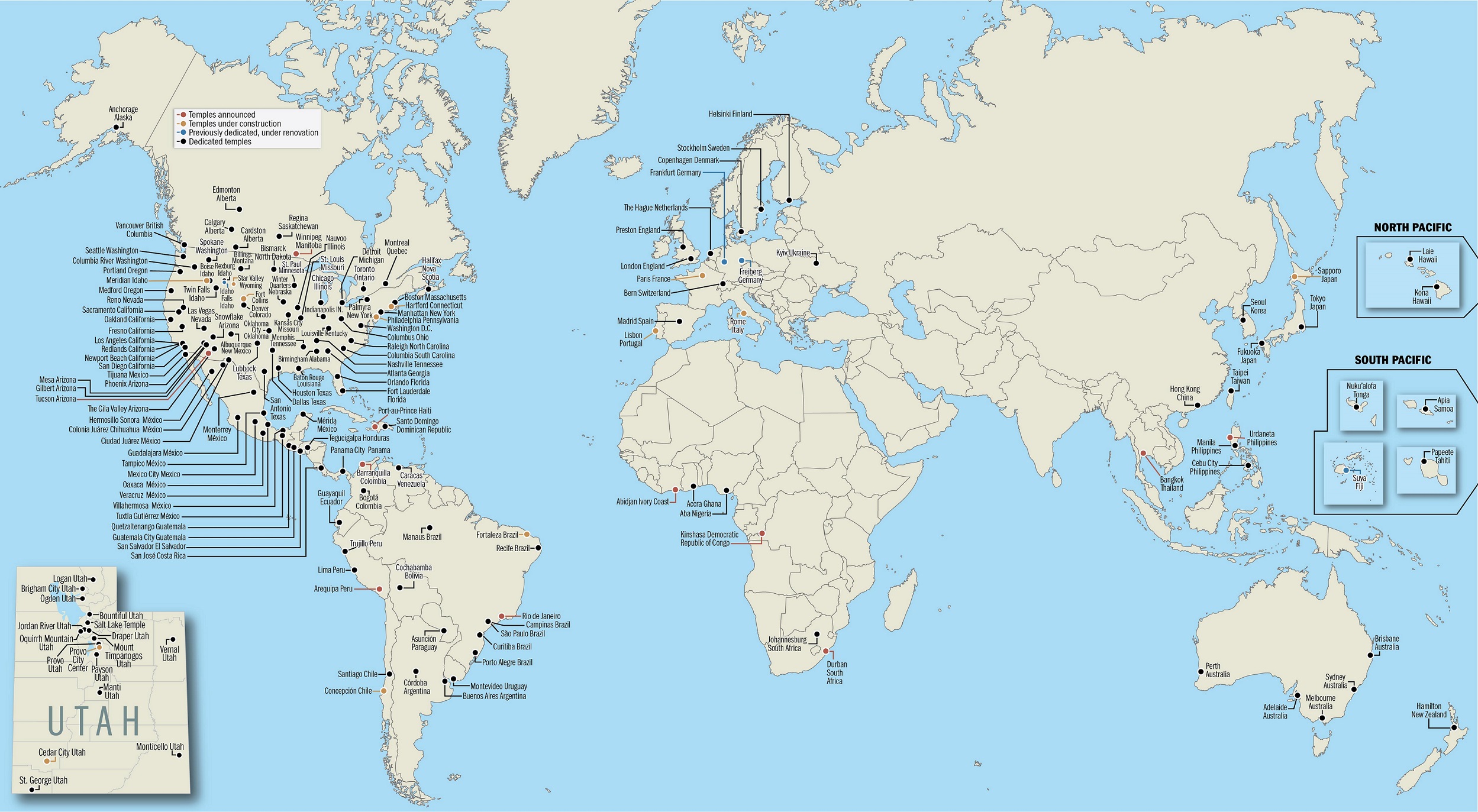Difference between revisions of "Mormon Temples"
(→Smaller Temples) |
|||
| (One intermediate revision by the same user not shown) | |||
| Line 67: | Line 67: | ||
==Preservation of Historic Temples== | ==Preservation of Historic Temples== | ||
| − | Four temples are considered [[Pioneer Temples|pioneer temples]]; their construction dating back to the early years following the restoration of the gospel of Jesus Christ and the organization of The Church of Jesus Christ of Latter-day Saints. These include the [[St. George Temple]] (originally dedicated in 1877), the [[Logan Temple]] (originally dedicated in 1884), the [[Manti Temple]] (originally dedicated in 1888), and the [[Salt Lake Temple]] (originally dedicated in 1893). Of them, President Nelson said: "The earliest ones stand as monuments to the faith and vision of our beloved pioneers. Each temple constructed by them resulted from their great personal sacrifice and effort. Each one stands as a stunning jewel in the crown of pioneer achievement. | + | Four temples are considered [[Pioneer Temples|pioneer temples]]; their construction dating back to the early years following the restoration of the gospel of Jesus Christ and the organization of The Church of Jesus Christ of Latter-day Saints. These include the [[St. George Utah Temple]] (originally dedicated in 1877), the [[Logan Utah Temple]] (originally dedicated in 1884), the [[Manti Utah Temple]] (originally dedicated in 1888), and the [[Salt Lake Temple]] (originally dedicated in 1893). Of them, President Nelson said: "The earliest ones stand as monuments to the faith and vision of our beloved pioneers. Each temple constructed by them resulted from their great personal sacrifice and effort. Each one stands as a stunning jewel in the crown of pioneer achievement. |
"Ours is a sacred responsibility to care for them. Therefore, these pioneer temples will soon undergo a period of renewal and refreshing and, for some, a major restoration. Efforts will be made to preserve the unique historicity of each temple wherever possible, preserving the inspiring beauty and unique craftsmanship of generations long-since passed. | "Ours is a sacred responsibility to care for them. Therefore, these pioneer temples will soon undergo a period of renewal and refreshing and, for some, a major restoration. Efforts will be made to preserve the unique historicity of each temple wherever possible, preserving the inspiring beauty and unique craftsmanship of generations long-since passed. | ||
| Line 87: | Line 87: | ||
==Smaller Temples== | ==Smaller Temples== | ||
| + | The Ephraim Temple will be built in a small college community. [[Sarah Jane Weaver]], editor of the ''Church News,'' noted the significance. | ||
| + | |||
| + | : The temples in Vanuatu and Kiribati — two of 70 announced by President Nelson during his time as leader of the Church — are among numerous temples announced for smaller communities of faithful Latter-day Saints. In April 2021 general conference, President Nelson announced the Church would build temples in Burley, Idaho; Smithfield, Utah; Grand Junction, Colorado; Farmington, New Mexico; and Casper, Wyoming. | ||
| + | |||
| + | :He also announced temples for areas that include larger geographic Church units — Oslo, Norway; Brussels, Belgium; Cali, Colombia; and Cape Town, South Africa. And for areas where regular temples attendance has previously required substantial travel or great personal sacrifice — Kumasi, Ghana; Beira, Mozambique; Singapore; and Belo Horizonte, Brazil. | ||
| + | |||
| + | :And just a few weeks ago, President Nelson announced a new temple for Ephraim, Utah — a small college town in central Utah just seven miles from the Manti Utah Temple. | ||
| + | |||
| + | :I knew each temple location was revealed to a living prophet. Still, I searched for a pattern that would connect the temple sites. | ||
| + | |||
| + | :Speaking to the media after President Nelson announced the new Ephraim temple, Elder [[Kevin R. Duncan]], a General Authority Seventy and executive director of the Temple Department, offered insight. He said the Church is working to build temples “nearer the people so they can go to the temple frequently.” | ||
| + | |||
| + | :He spoke about temples for smaller communities and then envisioned a time when the Church would have multiple temples in large cities that are hard to navigate. “Instead of one large temple that is hard to get to, you can have multiple temples that are easy to get to,” he said. | ||
| + | |||
| + | :Elder Duncan said Church leaders “are making the temple accessible.” | ||
| + | |||
| + | :The pattern was simple, I realized. The Church is building temples everywhere — allowing Latter-day Saints across the world to claim the blessings of their covenants. | ||
| + | |||
| + | :Elder Duncan said Church leaders all anticipate a day very soon when temples will literally “dot the globe” — with every member living within two hours of a temple, or much, much closer. | ||
| + | |||
| + | :In April 2021 general conference, President Nelson explained why it matters — to the Latter-day Saints in Ephraim and Kiribati and Vanuatu and Singapore. And he explained why it matters to me. | ||
| + | |||
| + | :“Temples are a vital part of the Restoration of the gospel of Jesus Christ in its fullness,” he said. “The ordinances of the temple fill our lives with power and strength — available in no other way.”[https://www.thechurchnews.com/temples/2021-05-15/sarah-jane-weaver-temples-pattern-connects-small-towns-large-cities-213205] | ||
==Videos about Temples== | ==Videos about Temples== | ||
Revision as of 18:26, 20 May 2021
During the October general conference in 1902, Church President Joseph F. Smith said he hoped that one day the Church would "have temples built in the various parts of the [world] where they are needed for the convenience of the people." The work performed in holy temples, a work restored to the earth by ministering angels under the direction of God the Father and His son, Jesus Christ, sets The Church of Jesus Christ of Latter-day Saints (Mormon Church) apart from the rest of the contemporary Christian world.
President Joseph F. Smith first used the phrase of temples “dotting the land”—referencing Europe during several conferences with members there in the early 1900s. At the April 2000 general conference, Elder Russell M. Nelson echoed the “dotting” phrase: “Families are to be sealed together for all eternity. A welding link is to be forged between the fathers and the children. … For these sacred purposes, holy temples now dot the earth” (“The Creation,” Ensign, May 2000).[1]
In a general conference address in April 2011, President Thomas S. Monson noted that since the very early days of the Restoration, Latter-day Saints have been a temple-building and a temple-loving people. In that same address, President Monson also said 85 percent of the Church lives within 200 miles of a temple.
Update: 160 Dedicated Temples; 8 Temples being renovated; 36 Temples under construction; 48 Temples announced as of May 2021[2]
The Church currently has 160 temples in operation in over 40 countries around the world. Forty-eight more temples have been announced and 36 are already under construction. Of those temples in operation, 13 are in Africa, 18 in Asia, 16 in Europe, 16 in Oceania, 31 in South America, and 74 in North America. More than 60 percent of the operating temples have been dedicated during the last decade (See Chronological List of Temples). The exponential growth in the number of Latter-day Saint temples coincides with the tremendous growth of the Church around the world.
Several temples are being renovated - the Tokyo Japan Temple, Washington D.C. Temple, Mesa Arizona Temple, Hamilton New Zealand Temple, Salt Lake Temple, St. George Utah Temple, Hong Kong China Temple, and the Columbus Ohio Temple
President Gordon B. Hinckley (who himself dedicated or re-dedicated over 80 temples) did much to spread the blessings of the temple to members. Said he: "We have done all that we know how to do to bring temples closer to our people. There are still many who have to travel long distances. I hope they will continue to make that effort" ("Closing Remarks," Ensign, Nov. 2004, 104).
Contents
Holiness to the Lord, the House of the Lord
According to President Nelson, "Each holy temple stands as a symbol of our membership in the Church, as a sign of our faith in life after death, and as a sacred step toward eternal glory for us and our families" (Russell M. Nelson, “Personal Preparation for Temple Blessings,” Ensign, May 2001, 32)
The Church of Jesus Christ dedicates all of its buildings to the worship of God and as places where the Holy Spirit can reside and bless and inspire those who enter. But unlike these other buildings, Latter-day Saint temples are dedicated to being the houses of the Lord: sacred, special, and set apart from the rest of the world. As a House of the Lord, it is the Lord who sets the standard whereby people may enter. Those who enter the temple must do so worthily. Members must be keeping the commandments and hold what is known as a temple recommend, a card signed by the bishop and stake president stating that the person is worthy. The Lord invites all men and women to become worthy to come to the temple.
In the temple faithful members of the Church of Jesus Christ perform ordinances essential to the salvation of mankind and enter into covenants with the Lord. The temple is like a school where men and women learn about sacred and eternal things. The temple can be considered as a presentation, in figurative terms, of the pattern and journey of life on earth often referred to as the Plan of Salvation. In Latter-day Saint temples, holy truths are taught and solemn covenants are made not only by the individual members on their own behalf but also on behalf of others who have died.
Temples and the Work for the Dead
When the Lord Jesus Christ was living on this earth, He clearly explained that there was only one way by which man can be saved. He said: "I am the way, the truth, and the life: no man cometh unto the Father, but by me" (John 14:6).
Two things emerge as essential if one is to believe the previous statement. First, in His name rests the authority to save mankind, as explained in this scripture found in the Bible: "for there is none other name under heaven given ... whereby we must be saved" (Acts 4:12). Second, there is an essential ordinance, baptism, which is the gate through which every soul must pass in order to obtain eternal life, as explained in this other scripture: “Jesus answered, Verily, verily, I say unto thee, Except a man be born of water and of the Spirit, he cannot enter into the kingdom of God” (John 3:5).
Since baptism is essential, and the authority to act in the name of Jesus Christ has been restored on the earth through the prophet Joseph Smith, the Church of Jesus Christ is anxiously engaged in carrying the message of the gospel of Jesus Christ to every nation, kindred, tongue, and people. This proselyting assignment came as a commandment from Him, “Go ye therefore, and teach all nations, baptizing them in the name of the Father, and of the Son, and of the Holy Ghost” (Matthew 28:19). In The Church of Jesus Christ of Latter-day Saints, members accept the responsibility to preach the gospel to every person on earth. The goal is to bring the blessings of the gospel and the ordinances of salvation to the entire world. But is this possible? What about the millions or billions of people who already died without baptism? Are they doomed to “burn in hell”, or at least to be deprived of the greatest blessing of our God?
According to the Bible and Church doctrine, mankind can only be saved through the name of Jesus Christ and through baptism, but most of the people who ever lived on the earth knew nothing about these two prerequisites. So, is God mindless of the billions of people who did not have the opportunity to hear the Gospel and be baptized by the proper authority?
The answer to this was revealed by God Himself. Through revelation, God instructed the Prophet, Joseph Smith, to build temples where ordinances such as baptism could be performed not only for the living but also for the dead. In the New Testament we read, "Else what shall they do which are baptized for the dead, if the dead rise not at all? Why are they then baptized for the dead?" (1 Corinthians 15:29).
The reality of the resurrection makes baptism for the dead not only meaningful but critical to the salvation of millions who have died without receiving baptism while alive. Jesus, during the time between his death and resurrection, went into the spirit world and preached the gospel (see 1 Peter 3:19-20; 4:6). The purpose of the Savior's preaching to the dead in the spirit world was to give them the opportunity of hearing and accepting the gospel so that later a vicarious baptism could be performed for them. "For for this cause was the gospel preached also to them that are dead, that they might be judged according to men in the flesh, but live according to God in the spirit" (1 Peter 4:6).
To some, having ordinances performed for the dead may seem like an imposition, but that is neither how it works nor how it was intended to work. When Jesus Christ atoned for the sins of the world, He did for people everywhere what they could not do for themselves. The effects and blessings of Christ's Atonement and Resurrection can be received by every member of the human family. The offer of salvation is to all, but because people have agency they must choose for themselves whether they will accept or reject Christ's offer.
Because of Christ's Atonement and Resurrection, and through the power and authority of the Priesthood, Latter-day Saints can do for the dead, what the dead cannot do for themselves. This work can only be done in temples. When ordinances are performed for someone who has died, it does not in any way take away their agency or choice in the matter. Just the opposite, if no work is done, the person has no options to choose between. Once work has been done, they may use their ability to choose to either accept or reject the ordinances performed. Latter-day Saints believe everyone who has ever lived should have the chance to make that choice. For this reason, temple work and family history will continue to be an integral part of the Church of Jesus Christ of Latter-day Saints.
Temples During the Life and Service of President Russell M. Nelson
In his general conference address, given during the Sunday morning session on 5 April 2020, Elder David A. Bednar of the Quorum of the Twelve Apostles acknowledged the Church’s 168 operating temples, adding that "49 additional temples are under construction or have been announced."
In President Russell M. Nelson's concluding remarks later Sunday afternoon,[3], he announced eight new temple locations, bringing the total of temples under construction or announced to 57.
Elder Bednar added that the Church is expecting to break ground for and start construction on 18 new temples in 2020 — by contrast, the Church needed 150 years from its organization in 1830 to dedicate its 18th operating temple.
Elder Bednar further commented:
- When President Nelson was born on 9 September 1924, The Church of Jesus Christ of Latter-day Saints had six operating temples. On 7 April 1984, 60 years later, when President Nelson was ordained as an apostle, 26 temples were operating—an increase of 20 temples in 60 years. When President Nelson was sustained as President of the Church, 159 temples were operating, an increase of 133 temples in the 34 years during which he served as a member of the Quorum of the Twelve Apostles. Since becoming the President of the Church on 14 January 2018, President Nelson has announced 35 new temples. Ninety-six percent of the existing temples have been dedicated during President Nelson’s lifetime; 84 percent have been dedicated since he was ordained an apostle.
In the October 2020 general conference, President Nelson announced six new temples. In the April 2021 general conference, he announced twenty more. On May 1, he announced that a new temple would be built in Ephraim, Utah. The temple in Ephraim will be the 252nd temple in the Church and the 27th in Utah.
The following is a map of temples in President Nelson’s lifetime. This map, as well as other maps showing temple locations worldwide mapped according to the timeline of President Nelson's life and service, can be found on the Church News website.
Preservation of Historic Temples
Four temples are considered pioneer temples; their construction dating back to the early years following the restoration of the gospel of Jesus Christ and the organization of The Church of Jesus Christ of Latter-day Saints. These include the St. George Utah Temple (originally dedicated in 1877), the Logan Utah Temple (originally dedicated in 1884), the Manti Utah Temple (originally dedicated in 1888), and the Salt Lake Temple (originally dedicated in 1893). Of them, President Nelson said: "The earliest ones stand as monuments to the faith and vision of our beloved pioneers. Each temple constructed by them resulted from their great personal sacrifice and effort. Each one stands as a stunning jewel in the crown of pioneer achievement.
"Ours is a sacred responsibility to care for them. Therefore, these pioneer temples will soon undergo a period of renewal and refreshing and, for some, a major restoration. Efforts will be made to preserve the unique historicity of each temple wherever possible, preserving the inspiring beauty and unique craftsmanship of generations long-since passed.
"Details for the St. George Utah Temple have already been released. Plans for the renovation of the Salt Lake Temple, Temple Square, and the adjoining plaza near the Church Office Building will be announced on Friday, April 19, 2019.
"The Manti and Logan Utah Temples will also be renovated in coming years. When those plans are prepared, they too will be announced.
"This work will require that each temple be closed for a period of time. Church members may continue to enjoy temple worship and service in other temples nearby. When each project is completed, each historic temple will be rededicated.[4]
In March 2021, the First Presidency released a statement about the renovation of the Salt Lake Temple, indicating that the temple would transition from a room-to-room presentation by live actors to single-room presentations by film. Additionally, they announced that the murals, for several reasons, would not be restored in situ, but were "carefully photographed and documented before removal, and some of the original portions are being preserved in the Church’s archives. Many other historic features of the building have also been photographed, documented, replicated and in some cases, architecturally salvaged."[5]
The First Presidency also indicated that the Manti Temple would go through similar alterations. However, on May 1, 2021, President Nelson, acting upon the revelation he had received, spoke to members of the Manti Temple district via media technology. He said that Church leaders sought the direction of the Lord on renovation plans and were "impressed to modify our earlier plans so that the pioneer craftsmanship, artwork and character will be preserved, including temple murals."[6] He also announced the construction of a second temple in the area in Ephraim, Utah.
- “These decisions will expand future opportunities for members in this temple district to participate in sacred temple ordinances, and at the same time allow us to preserve the unique classical character and useful life of the historic Manti Utah Temple,” said President Nelson.[7]
The Manti Temple is scheduled for closure on October 1, 2021.
Smaller Temples
The Ephraim Temple will be built in a small college community. Sarah Jane Weaver, editor of the Church News, noted the significance.
- The temples in Vanuatu and Kiribati — two of 70 announced by President Nelson during his time as leader of the Church — are among numerous temples announced for smaller communities of faithful Latter-day Saints. In April 2021 general conference, President Nelson announced the Church would build temples in Burley, Idaho; Smithfield, Utah; Grand Junction, Colorado; Farmington, New Mexico; and Casper, Wyoming.
- He also announced temples for areas that include larger geographic Church units — Oslo, Norway; Brussels, Belgium; Cali, Colombia; and Cape Town, South Africa. And for areas where regular temples attendance has previously required substantial travel or great personal sacrifice — Kumasi, Ghana; Beira, Mozambique; Singapore; and Belo Horizonte, Brazil.
- And just a few weeks ago, President Nelson announced a new temple for Ephraim, Utah — a small college town in central Utah just seven miles from the Manti Utah Temple.
- I knew each temple location was revealed to a living prophet. Still, I searched for a pattern that would connect the temple sites.
- Speaking to the media after President Nelson announced the new Ephraim temple, Elder Kevin R. Duncan, a General Authority Seventy and executive director of the Temple Department, offered insight. He said the Church is working to build temples “nearer the people so they can go to the temple frequently.”
- He spoke about temples for smaller communities and then envisioned a time when the Church would have multiple temples in large cities that are hard to navigate. “Instead of one large temple that is hard to get to, you can have multiple temples that are easy to get to,” he said.
- Elder Duncan said Church leaders “are making the temple accessible.”
- The pattern was simple, I realized. The Church is building temples everywhere — allowing Latter-day Saints across the world to claim the blessings of their covenants.
- Elder Duncan said Church leaders all anticipate a day very soon when temples will literally “dot the globe” — with every member living within two hours of a temple, or much, much closer.
- In April 2021 general conference, President Nelson explained why it matters — to the Latter-day Saints in Ephraim and Kiribati and Vanuatu and Singapore. And he explained why it matters to me.
- “Temples are a vital part of the Restoration of the gospel of Jesus Christ in its fullness,” he said. “The ordinances of the temple fill our lives with power and strength — available in no other way.”[8]
Videos about Temples
Additional Resources
External Links
- Please click on this link or on the thumbnail "I Love to See the Temple" below to view Brian Olson's 2012 - 2015 LDS Temples InfoGraphics.





